Introduction
In the rapidly evolving landscape of e-commerce, subscription-based models are redefining customer engagement and revenue generation. By offering products and services on a recurring basis, businesses can cultivate lasting relationships with their customers while securing predictable income streams.
This innovative approach not only enhances customer loyalty but also opens doors to new growth opportunities, particularly as consumers increasingly gravitate towards subscription offerings.
As organizations navigate this dynamic market, understanding the nuances of various subscription models and leveraging data analytics will be crucial for optimizing performance and driving success.
With a keen focus on strategic implementation, companies can harness the power of subscriptions to not only meet but exceed customer expectations, positioning themselves at the forefront of the e-commerce revolution.
Understanding Subscription-Based E-Commerce Models
Subscription-based e-commerce strategies have fundamentally changed the manner in which companies interact with their clients by offering products and services on a recurring basis. This model encompasses various approaches, including:
- Software as a Service (SaaS)
- Box services
- Membership platforms
All of which enable companies to establish continuous revenue streams. A recent study reveals that 59% of shoppers have made a purchase on social media, highlighting the potential of integrating membership models with social commerce to enhance client reach and engagement.
To navigate this landscape, businesses must prioritize understanding consumer needs and preferences, which are crucial for defining pricing strategies and determining the frequency of delivery. Each subscription model has distinctive characteristics; for example, subscription boxes often focus on curated experiences that please users, while SaaS solutions prioritize delivering regular updates and robust client support.
Recent trends in subscription-based e-commerce strategies, particularly in 2024, indicate a rise in strategic alliances aimed at market expansion, alongside the growing popularity of specialized subscription boxes that cater to niche interests. Insights from the case study on 'Trends in Subscription E-commerce' highlight how these alliances are fostering innovation and driving consumer engagement. Additionally, the integration of AI and predictive analytics is shaping the future of this market, enhancing experiences by providing personalized recommendations and optimizing service delivery.
Companies must analyze their target market meticulously to select the most suitable membership model that aligns with their business objectives and resonates with their customers' preferences, especially in a climate where:
- 33% of consumers feel that brands use their data responsibly
- 42% believe their data is being exploited
Additionally, citing the financial performance data from Table 83: The Kroger Co. can provide valuable insights into the economic feasibility of membership models. By leveraging over 20 years of unparalleled global experience and insights into tailored online retail solutions, directors can strategically position their offerings to capture and retain the modern consumer, fostering community value by enhancing retention rates, boosting Average Order Value (AOV), and increasing Lifetime Value (LTV), while also building incremental revenue through custom solutions that directly address internal goals and KPIs.
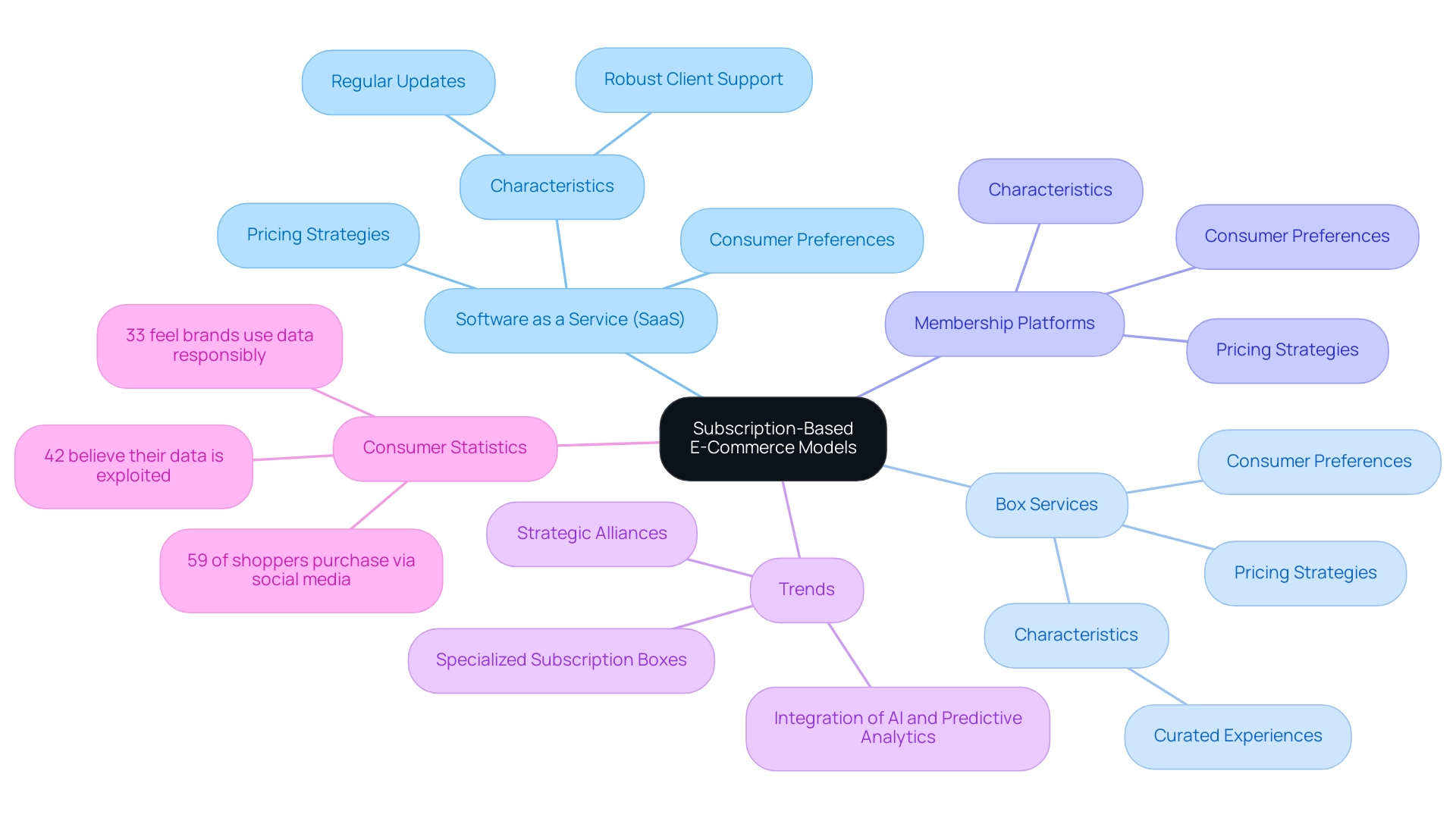
The Advantages of Subscription Models for E-Commerce Success
The shift to subscription-based e-commerce strategies provides e-commerce enterprises a range of benefits, primarily the creation of consistent revenue streams that aid in better cash flow management. This financial stability not only allows for more strategic planning but also supports sustained growth. Significantly, membership services foster strong client loyalty; subscribers frequently establish a sense of dedication to the brand, resulting in repeat purchases and increased lifetime value.
Furthermore, as companies like Dollar Shave Club have shown, such models can greatly reduce customer acquisition expenses over time. Satisfied subscribers are more inclined to refer others, amplifying organic growth. As emphasized by industry experts, the global recurring e-commerce market is anticipated to demonstrate a compound annual growth rate (CAGR) of 41.38% from 2025 to 2033, indicating a strong opportunity for companies prepared to adopt subscription-based e-commerce strategies.
Moreover, the growth of paid services is reflected in platforms such as YouTube, which has experienced a notable rise in paying members from 2020 to 2024. This trend underscores the growing consumer preference for subscription-based e-commerce strategies. Moreover, financial performance information for companies such as The Kroger Co. demonstrates how membership models can improve revenue stability and growth.
With over 20 years of experience, we have developed customized online commerce solutions that enhance critical KPIs such as retention rates, Average Order Value (AOV), and Lifetime Value (LTV). By aligning subscription-based e-commerce strategies with your internal goals and community needs, our solutions not only generate incremental revenue but also significantly enhance stability and boost growth potential, making subscription-based e-commerce strategies essential for contemporary online commerce.
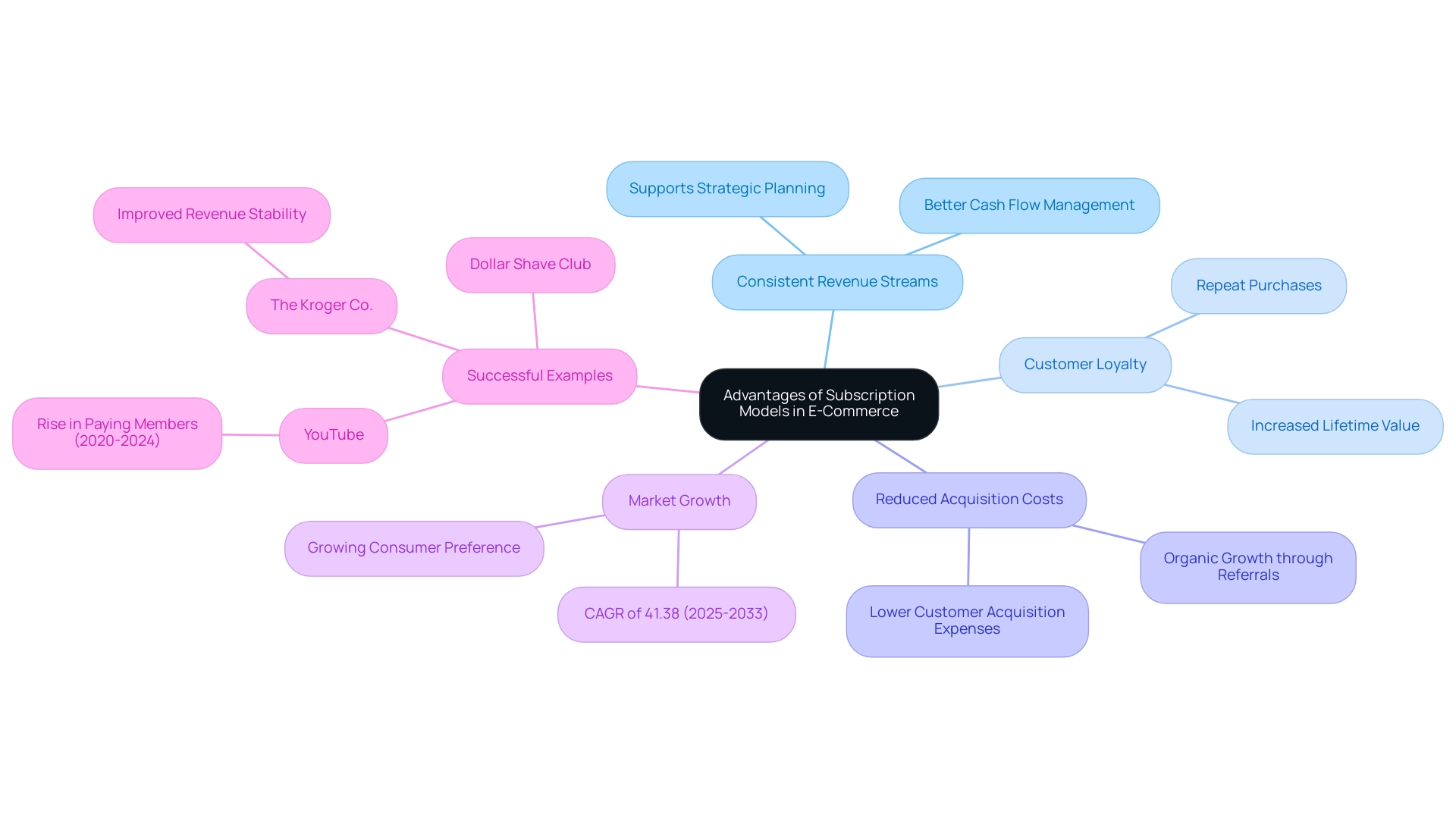
Implementing Effective Subscription Strategies: Onboarding and Customer Engagement
Successfully integrating new subscribers is crucial for building a solid base for client relationships in online retail. Companies should prioritize creating a seamless registration process, leveraging welcome emails that guide users through initial steps while showcasing the service's key features. Our tailored e-commerce solutions, backed by over 20 years of global experience, can significantly enhance retention rates, Average Order Value (AOV), and Lifetime Value (LTV), ultimately building community value.
Regular engagement through personalized emails and exclusive offers can enhance the experience and drive incremental revenue. According to recent statistics:
- Over 90% of clients feel that organizations could enhance their onboarding processes, indicating a clear opportunity for enterprises to refine their approaches.
- Furthermore, 75% of clients expect a consistent experience across all platforms, underscoring the need for a cohesive onboarding strategy.
Gathering feedback through surveys not only helps refine offerings but also aligns services more closely with subscriber needs. A prime example of successful onboarding is Netflix, which utilizes user data to provide tailored content recommendations, thereby enhancing user satisfaction and engagement. Additionally:
- 92% of HR professionals are familiar with using AI in onboarding,
- 87% are committed to adopting AI for hiring and onboarding processes, showcasing the role of technology in enhancing the onboarding experience.
Grace Lau, Director of Growth Content, notes that 2 in 5 HR managers spend at least 3 hours collecting onboarding information manually, highlighting the challenges faced in effective onboarding. Evidence also suggests that employees who experience effective onboarding are 30 times more likely to report overall job satisfaction, underscoring the importance of structured onboarding processes. By adopting continuous engagement strategies, businesses can not only improve customer satisfaction but also significantly boost retention rates and revenue, making onboarding a critical component of long-term success in subscription-based services.
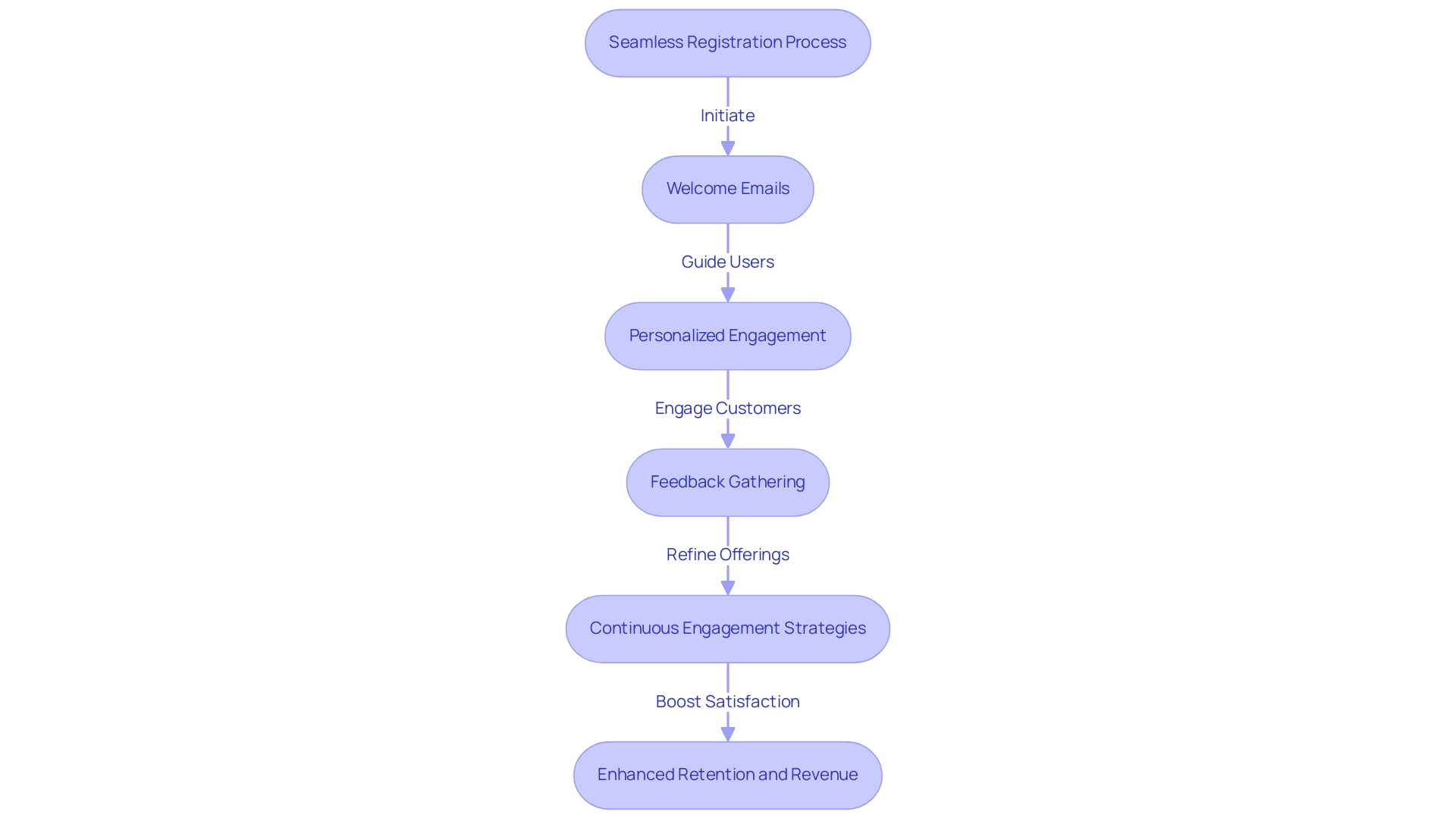
Leveraging Data Analytics for Subscription Optimization
Data analytics has emerged as a cornerstone for enhancing membership offerings in the online shopping environment. As the e-commerce platform industry is projected to grow at a compound annual growth rate (CAGR) of 15.40% from 2024 to 2032, leveraging advanced analytics tools becomes increasingly crucial for sustained success. E-commerce businesses should harness platforms like Google Analytics, relationship management (CRM) systems, and specialized subscription management tools to extract actionable insights regarding consumer behavior and preferences.
Monitoring key metrics, particularly churn rates, is essential for identifying potential retention challenges before they escalate. By implementing targeted strategies based on churn analysis, companies can proactively address issues and enhance client loyalty.
Furthermore, it is important to consider the rising privacy concerns consumers have regarding AI technologies in 2024, as these issues may influence how data analytics strategies are developed and implemented. Companies must ensure that their use of analytics respects consumer privacy to maintain trust and compliance in an evolving regulatory landscape.
Employing A/B testing on various pricing models can illuminate which structures resonate most effectively with clients, ultimately driving conversion rates. For instance, companies such as Spotify utilize user data to refine their offerings continuously, delivering personalized experiences that enhance user satisfaction and retention. The acquisition of ProfitWell by Paddle exemplifies the growing importance of sophisticated analytics in subscription-based e-commerce strategies, as it offers comprehensive insights and tools, such as pricing optimization and customer retention strategies, to enhance financial performance.
According to Koen van Gelder, Team Lead of online retail,
In 2024, retail online sales are estimated to exceed 4.1 trillion U.S. dollars globally, and this figure is expected to reach new heights in the coming years.
This underscores the necessity for e-commerce directors to prioritize data analytics in their growth strategies to remain competitive, while also being mindful of privacy considerations.
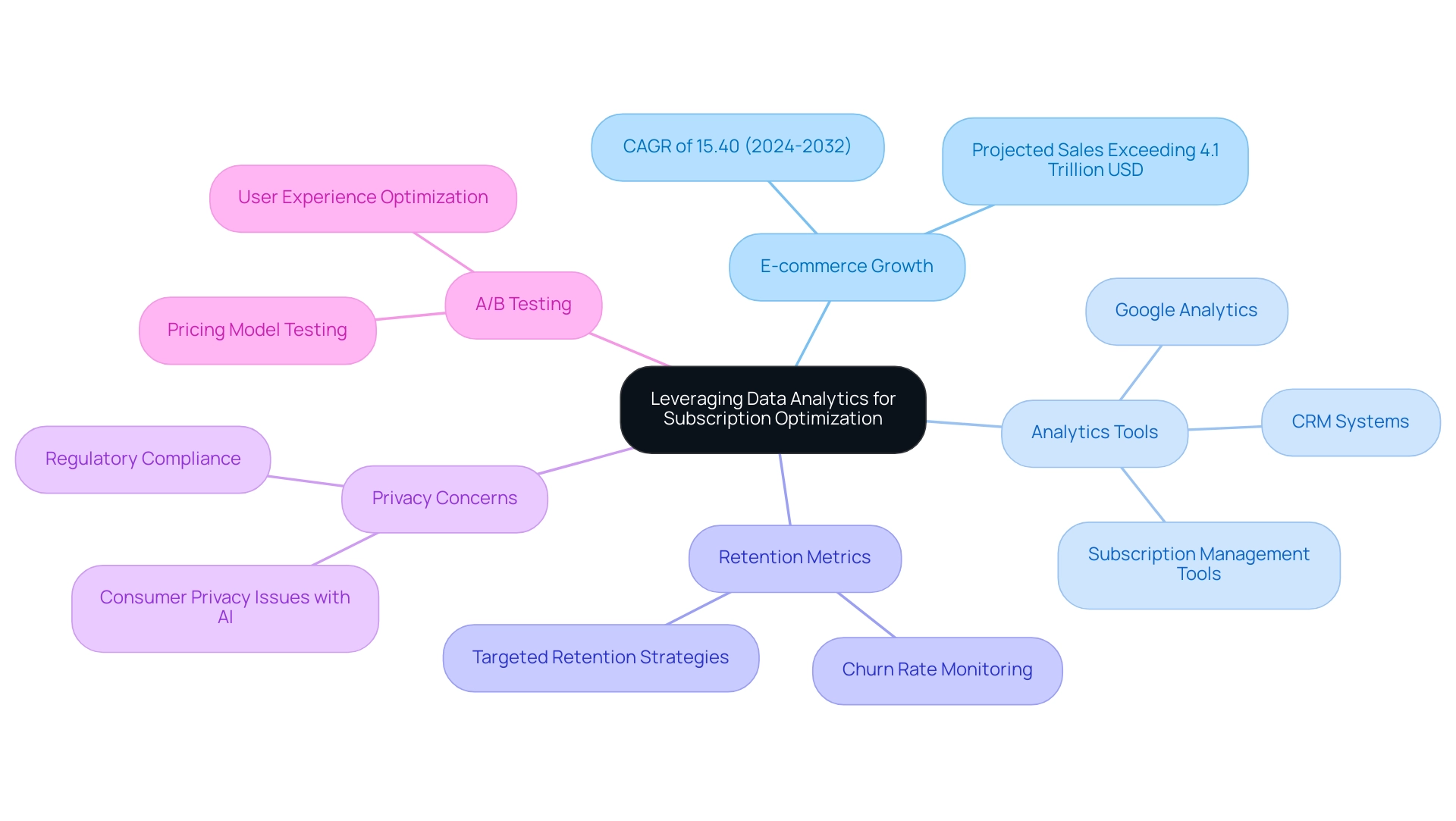
Marketing Strategies for Subscription-Based E-Commerce
Marketing subscription-based e-commerce strategies requires a strategic and multifaceted approach. Leveraging social media marketing, content marketing, and targeted email campaigns is essential for effectively reaching potential subscribers. Understanding how to market on various social media platforms is integral to every business's success.
Creating captivating material that expresses the distinct advantages of each plan can greatly boost interest and involvement. Influencer partnerships emerge as a powerful avenue to expand reach, with subscription box services often collaborating with influencers to showcase their offerings and generate buzz. Notably, 84% of brands and marketers report positive results from their PPC advertising campaigns, as stated by Ranktracker, indicating that paid strategies can further augment visibility and subscriber acquisition.
Moreover, our customized online retail solutions, backed by over 20 years of global experience, have a proven track record of enhancing critical KPIs for our clients, such as retention rates and Average Order Value (AOV), while also generating incremental revenue for organizations. Implementing referral programs encourages existing customers to introduce new subscribers, fostering a sustainable growth loop that benefits both the business and its clientele. Tailoring marketing messages to underscore value and convenience is crucial in converting prospects into loyal subscribers.
As 30% of subscribers account for nearly 80% of all revenue, focusing on retaining these loyalists through personalized marketing strategies will drive long-term success in subscription-based e-commerce strategies. Furthermore, leveraging insights on social selling, sales professionals with a robust social selling index on LinkedIn enjoy 45% more sales opportunities, illustrating the importance of a strong online presence in today’s competitive marketplace. The effectiveness of targeted email campaigns is exemplified by a case study on email segmentation, which reveals that segmented emails drive 30% more opens and 50% more clickthroughs than unsegmented emails, highlighting the value of strategic email marketing.
Our solutions also focus on building community value, creating products that resonate with the community and align directly with your internal goals and KPIs.
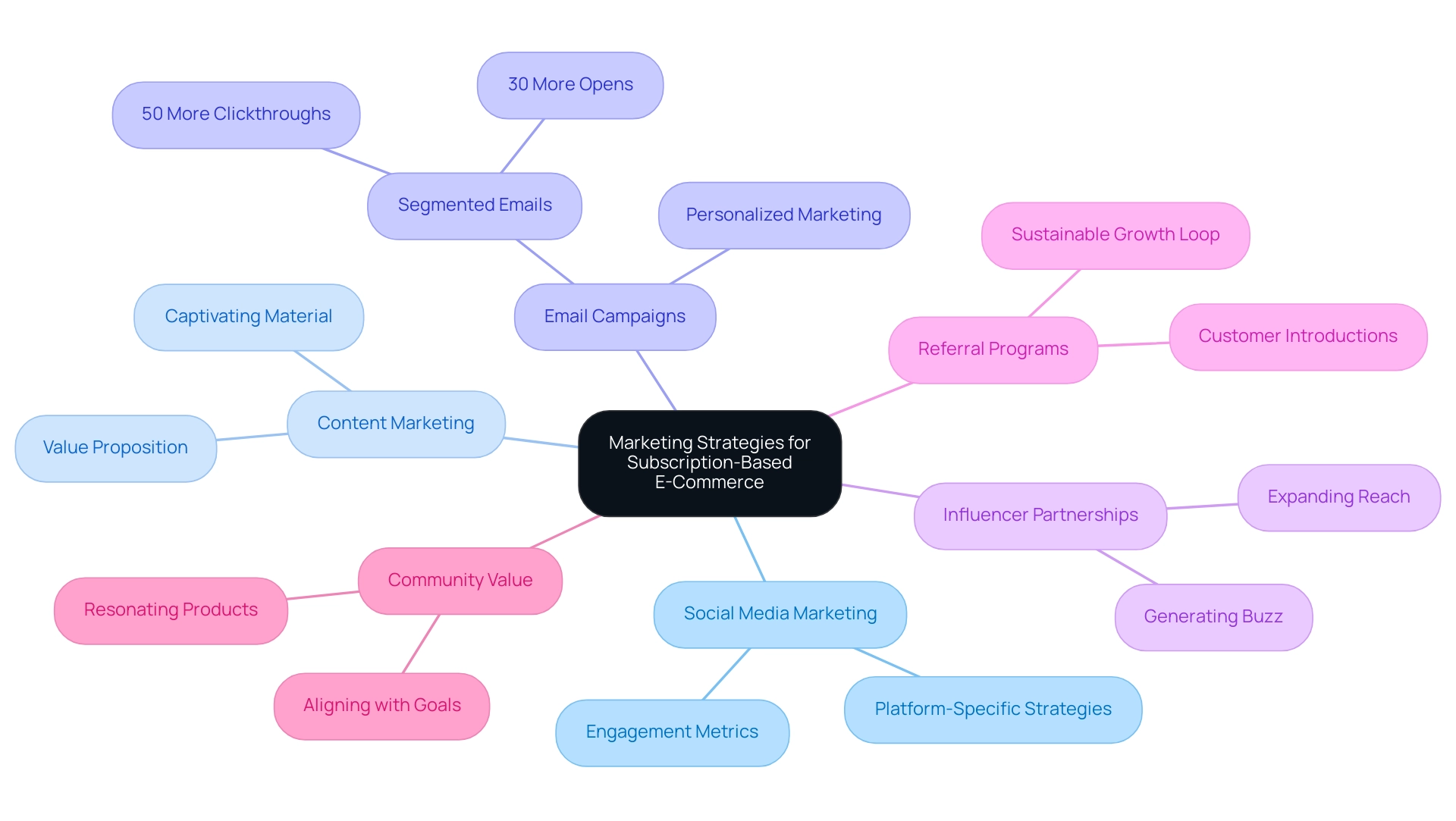
Conclusion
Subscription-based e-commerce has emerged as a transformative force in the retail landscape, reshaping how businesses interact with customers and generate revenue. By understanding the various subscription models available—from SaaS to curated subscription boxes—companies can create tailored offerings that resonate with consumer preferences and foster strong, lasting relationships. The data underscores the significance of these models, with a projected compound annual growth rate that highlights the sector's robust potential for growth.
Implementing effective subscription strategies is paramount. A seamless onboarding process, consistent engagement, and personalized experiences are critical to enhancing customer satisfaction and retention. The importance of data analytics cannot be overstated; by leveraging insights into customer behavior and preferences, businesses can optimize their offerings, address churn proactively, and maintain a competitive edge in a rapidly evolving market.
Moreover, strategic marketing approaches play an essential role in attracting and retaining subscribers. Utilizing social media, influencer partnerships, and targeted email campaigns can amplify visibility and engagement, ultimately driving revenue growth. As the subscription economy continues to expand, focusing on personalized marketing and community value will be vital for long-term success.
In conclusion, the subscription-based model presents a unique opportunity for e-commerce businesses to thrive in a dynamic environment. By prioritizing customer relationships, leveraging data analytics, and employing strategic marketing techniques, organizations can not only meet but exceed customer expectations, solidifying their position at the forefront of the e-commerce revolution. Now is the time for businesses to embrace this model and unlock its full potential for sustainable growth and success.





